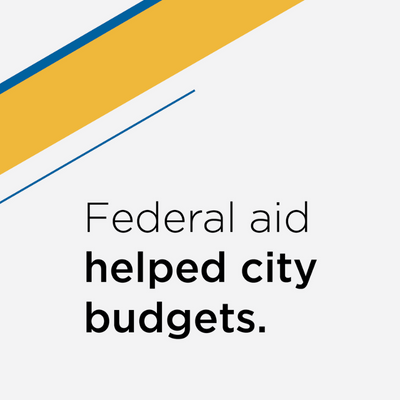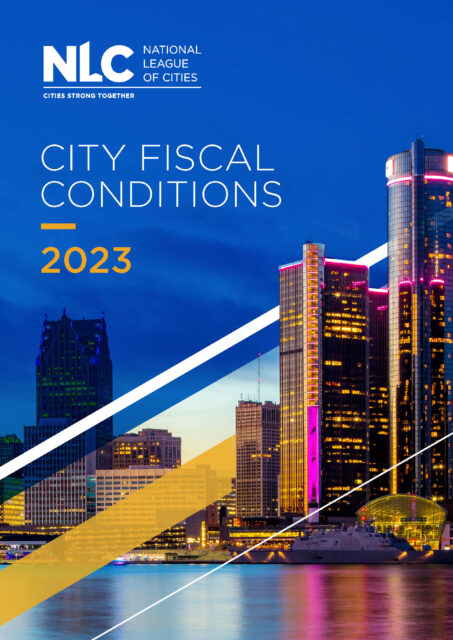Executive Summary
Three years after the pandemic outbreak, cities have recovered and have maintained a largely positive outlook about their near-term fiscal future. The 2023 City Fiscal Conditions report analyzes data on a total of 820 cities (including the responses from 533 city finance officers from municipalities of various population sizes). Here are four key takeaways from this year’s report:
- Cautious budgeting resulted in better preparation: The cautious approach by many cities in 2023 yielded increased reserves and limited spending, demonstrating that local governments remain good stewards of public dollars.
- Better able to weather inflation: Despite the challenge of inflation, the average city experienced more than a six percent increase in general fund revenues. Inflation is more manageable and cities are reaping some benefits of lower inflation.
- Federal aid had a positive Impact on city budgets: Direct federal aid through the American Rescue Plan Act (ARPA) and the bipartisan infrastructure law was among the factors that had a positive impact on cities’ ability to balance their 2023 budgets.
- Planning for uncertainties: Making it through a strong 2022 fiscal year, our survey analysis reveals that many cities are still very cautious in their budgeting. They anticipate potential risks and uncertainties in the post-COVID era as they plan for the current and next fiscal year. Among the concerns for local leaders is the expected end of federal funding through ARPA.
Overall, local economies are healthy and have seen the increased value of city taxes. Cities’ cautious approach to budgeting has helped them manage through these fiscally uncertain times.
Asked about factors that had the most positive impacts on cities’ ability to balance their 2023 budgets, 16% percent of respondents reported federal aid as having a positive impact.
The past several years have been challenging for America’s cities, towns, and villages but also full of opportunities and achievements. Despite facing abnormally high levels of inflation during 2022, cities have seen their tax values surge as post-pandemic economic activities picked up, property values rose, and unemployment rates dropped to historic lows. Below are a few key insights from the 2023 City Fiscal Conditions report.
Fiscal Structure and the Economy
Cities in the United States generate much of their revenue by designing their own tax and fee structures within limits imposed by their respective states. Consequently, cities’ fiscal structures vary across the country, with some relying heavily on property taxes and others primarily on sales taxes. Only a few cities—approximately one in 10—rely mostly on income or wage taxes.
Each source of revenue responds to economic changes differently. While property tax revenues are considered a lagging indicator of economic changes, sales taxes are elastic—or more responsive to economic changes—and often better reflect economic shifts.
Revenue and Spending Trends
This analysis includes final (audited) financial data for cities’ fiscal years 2021, 2022 and budgeted fiscal year 2023 revenues and expenditures.
Constant-dollar general fund revenues declined by 0.46 percent in fiscal year 2022 compared to fiscal year 2021, with cities anticipating a further year-over-year decline of 2.41 percent for fiscal year 2023. This is mainly because both sales and income tax revenues are expected to stabilize after a period of strong growth that occurred when the economy rebounded following the fiscal shock of the COVID-19 pandemic.

Interestingly, when examining nominal—not adjusted for inflation—figures, the average city experienced more than a six percent increase in its current (i.e., unadjusted for inflation) general fund revenues. This was due to a booming 2021 housing market that significantly increased property tax receipts and a rebound in the overall economy after the COVID-19 lockdown was lifted. This also brought sales tax receipts back to fiscal year 2019 levels, and was influenced by a large influx of federal monies through ARPA.
Explore the interactive table below to see the revenues and expenditures for municipalities between 2021 through 2023.
Tax Sources
Three principal general fund revenue sources have been tracked for the annual City Fiscal Conditions report for over 28 years1. As the figure below demonstrates, the year-to-year changes in each of the three major sources of revenues—property, sales and income—reflect the changing elements of the underlying economic bases of the cities.
As most cities expected the economy to go through a period of relative slowdown toward the latter half of 2023, cities tempered their expectations and estimated all three major types of tax revenues rather conservatively in their 2023 budget projections.2
Perspectives on the Ability to Meet Fiscal Needs

Following a strong 2022 fiscal year in which average city taxes increased significantly over fiscal year 2021, nearly seven out of ten finance officers report being better able to meet their financial needs in fiscal year 2023 than in 2022 (please refer to Appendix A for a discussion on the survey collection and analysis).
Timely federal interventions in the form of ARPA funds which provided direct financial support to cities’ general operations, coupled with a strong rebounding of the economy, contributed to the overall positive fiscal outlook reflected in city finance officers’ sentiment.
Despite a positive outlook for the fiscal year 2023, only about 50 percent of the same group of respondents reported optimism in balancing budgets for fiscal year 2024. The figure below shows the trend among cities’ ability to balance their budgets through the Great Recession and the pandemic. The reserved budgeting for 2024 is likely because many governments remain cautious due to the near-term period of fiscal uncertainty. Relatedly, many municipal governments have tempered their expectations for tax revenues in their 2023 operating budgets compared to large tax levels collected in fiscal year 2022.
Beyond 2023
Overall, both sales and income tax revenues have rebounded sharply for cities across the nation as early as 2021. However, the rebound in property tax revenues lagged and only started to increase again in 2023. As the country began to recover from the COVID-19 pandemic and states lifted lockdown orders in 2021, cities experienced a strong recovery in their economic activities and tax collections.
The cautious budgeting approach adopted by many cities in 2023 may prove to be beneficial in the long run, as they have built up some fiscal reserves and avoided excessive spending.

In conclusion, while cities, villages and towns faced difficulties in the last couple of years due to the COVID-19 pandemic and a period of high global inflation rates, they have shown resilience and adaptability in managing their finances. They should be able to look forward to a more optimistic and stable economic environment in 2023 and beyond.
Download the PDF report above to get even more insights and view the appendices.
Endnotes
1 While general fund revenues and expenditures have been tracked for 38 years, different revenue sources (property, sales, and income taxes) have been tracked for 28 years as part of the City Fiscal Conditions annual report.
2 In 2023 budget estimates.






